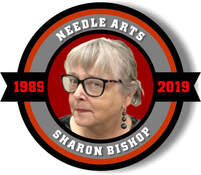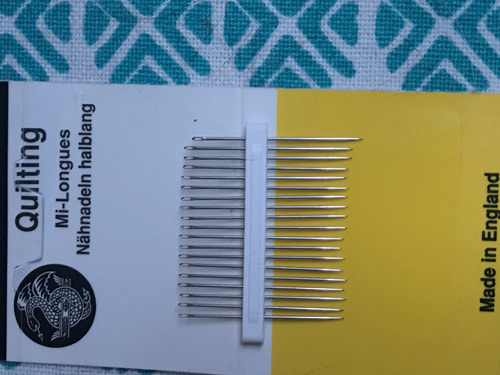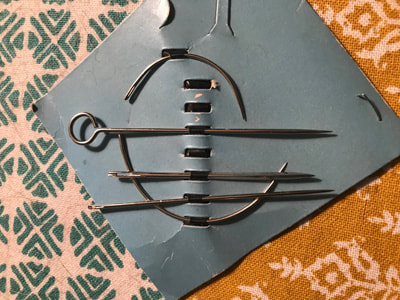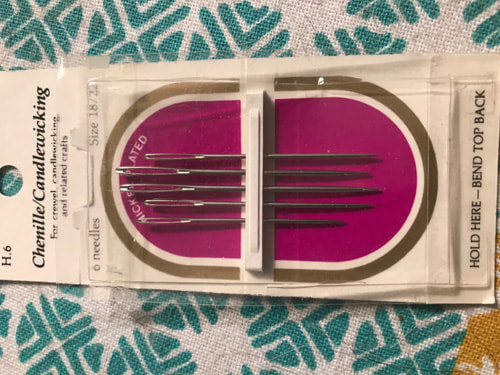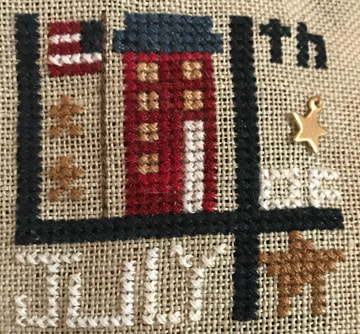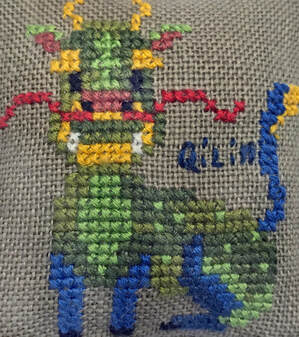Needle (n.) A fine, sharp implement usually for piercing such as sewing.
Needle (v.) Irritate, annoy, pester, provoke
Merriam Webster Dictionary
This month I am going to explore the noun’s usage of one of my favorite words.
An artist of any medium needs tools – items that allow the paint to flow, the clay to form and the stitch to be made. In the category of needle arts, a stitcher must have many tools in their toolbox. The first tool is the needle.
A needle receives the thread and is used to sew buttons on clothing, sew seams in clothing, and embroider flowers, animals or whatever you wish. Needles come in various shapes and sizes, and it depends on what fabric you are going to use that helps ascertain the size and shape of the needle.
All needles have an eye. This eye is usually flat on one size. The finer the needle, the harder it is to see the eye. Chenille needles are used with heavier weight fabrics – upholstery, velvets, denim. This needle usually has a much rounder shank and a very sharp point. Quilting needles are fine and even sharper, used with one strand of thread to make the finest of stitches. One also can use a quilting needle to bead with as it will go through the hole of the bead easily. There are needles called beading needles that are both long and short. There are needles that have an arch shape for sewing together leather. The needles that needle artists usually use is the tapestry needle.
The tapestry needle has a rounded point that allows the needle and thread to flow through the fabric without puncturing it. Most fabric used is woven. Can you stick yourself with this needle? Absolutely. The needles come in various sizes like 18, 20, 22, 24, 26 and 28. Why so many you ask? Well, the size of the needle relates to the thread being used and the fabric where the stitches are applied.
There are various needle threaders on the market today to help you get that pesky thread through the smallest of eyes. Myself, well I was taught by my maternal grandmother to thread a quilting needle when I was 7 years old. It is a skill that I still have today. Thanks, Nonnie.
More next month when I will present some of the most beautiful fabric available for the Needle artist.
Needle (v.) Irritate, annoy, pester, provoke
Merriam Webster Dictionary
This month I am going to explore the noun’s usage of one of my favorite words.
An artist of any medium needs tools – items that allow the paint to flow, the clay to form and the stitch to be made. In the category of needle arts, a stitcher must have many tools in their toolbox. The first tool is the needle.
A needle receives the thread and is used to sew buttons on clothing, sew seams in clothing, and embroider flowers, animals or whatever you wish. Needles come in various shapes and sizes, and it depends on what fabric you are going to use that helps ascertain the size and shape of the needle.
All needles have an eye. This eye is usually flat on one size. The finer the needle, the harder it is to see the eye. Chenille needles are used with heavier weight fabrics – upholstery, velvets, denim. This needle usually has a much rounder shank and a very sharp point. Quilting needles are fine and even sharper, used with one strand of thread to make the finest of stitches. One also can use a quilting needle to bead with as it will go through the hole of the bead easily. There are needles called beading needles that are both long and short. There are needles that have an arch shape for sewing together leather. The needles that needle artists usually use is the tapestry needle.
The tapestry needle has a rounded point that allows the needle and thread to flow through the fabric without puncturing it. Most fabric used is woven. Can you stick yourself with this needle? Absolutely. The needles come in various sizes like 18, 20, 22, 24, 26 and 28. Why so many you ask? Well, the size of the needle relates to the thread being used and the fabric where the stitches are applied.
There are various needle threaders on the market today to help you get that pesky thread through the smallest of eyes. Myself, well I was taught by my maternal grandmother to thread a quilting needle when I was 7 years old. It is a skill that I still have today. Thanks, Nonnie.
More next month when I will present some of the most beautiful fabric available for the Needle artist.
WHAT IS NEEDLE ART?
Why a Fabric-tastic Form of Creative Expression, That's What
Simply put, it is a function of taking fabric, thread and a needle and creating a design (form). Embroidery is the skill set you learn to accomplish your needle art. It is like an umbrella with a different technique serving as the spokes.
The techniques used are varied, with cross stitch, counted needlepoint, painted canvases and ribbon embroidery to name a few, that take something ordinary and turn it into needle art.
The design can be of your own making, or you can purchase a design to work. The choice is always yours.
I have been doing needle art since I was 7, when my grandmother taught me how to thread a quilting needle and sew little pieces of fabric together to form a shape. When I have a needle and thread in my hand I am truly happy. I do dabble in designing charts and I now have a YouTube channel called Stitching Kitchn (to find the channel, log into YouTube and type the Stitching Kitchn – note there is no “e” in Kitchn) to help people refresh their skills or start this great hobby.
It gives me great pleasure to see how the industry has grown, with so many talented people providing the products one needs to accomplish their needle art. Along with fabric, needles and threads there is a large variety of tools and accessories to help needle artists along the way, especially magnifiers.
Also, as we go along, I will be sharing with you some of my work. I look forward to future months when I will be visiting different types of needle art, giving you general history and the uses of these items.
Until then, consider trying something new or reviving an old, unfinished project.
The techniques used are varied, with cross stitch, counted needlepoint, painted canvases and ribbon embroidery to name a few, that take something ordinary and turn it into needle art.
The design can be of your own making, or you can purchase a design to work. The choice is always yours.
I have been doing needle art since I was 7, when my grandmother taught me how to thread a quilting needle and sew little pieces of fabric together to form a shape. When I have a needle and thread in my hand I am truly happy. I do dabble in designing charts and I now have a YouTube channel called Stitching Kitchn (to find the channel, log into YouTube and type the Stitching Kitchn – note there is no “e” in Kitchn) to help people refresh their skills or start this great hobby.
It gives me great pleasure to see how the industry has grown, with so many talented people providing the products one needs to accomplish their needle art. Along with fabric, needles and threads there is a large variety of tools and accessories to help needle artists along the way, especially magnifiers.
Also, as we go along, I will be sharing with you some of my work. I look forward to future months when I will be visiting different types of needle art, giving you general history and the uses of these items.
Until then, consider trying something new or reviving an old, unfinished project.
